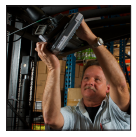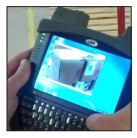Supply Chain of the Future
Minimize short-term disruptions to gain the agility needed to take on long-term disruptions
Executive Summary
In an uncertain world, investing in mobile computing will enhance your short-term flexibility in order to gain long-term confidence. The traditional instinct of individuals in the face of uncertainty is to sit tight and wait out the situation. The world moves too fast and is too interconnected today, making that approach outmoded.
To be a leader in the future, you will have to accept uncertainty, and minimize it everywhere you possibly can. Uncertainty is not going away any time soon, so the way to handle it is to use effective technology that minimizes the effects of uncertainty.
Remember: By minimizing short-term disruptions, you gain the confidence and agility needed to take on long-term disruptions.
Unpredictability has always been a part of the business climate, though perhaps more so today than ever. And its consequences, especially on the supply chain, have never been more dramatic.
Weather patterns, for example, are volatile to a degree unheard of just a few years ago. Supply chains, once largely domestic, now circle the globe. As a result, a weather or other event often leads to monumental supply-chain disruptions. In fact, a single local event can generate global consequences that last for months.
Increasingly, companies will need flexibility to adapt to short-term disruptions or they will be unable to effectively plan for the future. Supply chain planning is not built solely on projections but on the ability to handle the unexpected events that occur on an ongoing basis.
A Local Disruption Travels the Globe
The influence of short-term disruptions was powerfully seen in 2011. In March of that year, an earthquake and subsequent tsunami occurred in a corner of Japan. Among the facilities affected was one plant that produced a significant share of the world’s automotive microcontroller chips. This in turn slowed automobile production around the world for months. Then, as the supply chain was starting to return to normal, September saw floods in Thailand, a major manufacturing location for Japanese car makers. The resulting disruptions at plants in Thailand led to parts shortages for such Japanese companies as Toyota and Honda. The break in the supply chain produced problems at their car plants as far away as the U.S. and Canada.
The lesson: Day-to-day operations must be optimized or your ability to forecast your supply chain in the future will be hindered The more agile you are, the greater your ability to absorb short-term disruptions such as those just described. This, in turn, enhances your confidence and ability to forecast long-term goals and objectives.
Short-Term vs. Long-Term
The consequences of short-term disruptions on a company’s long-term performance can be severe. Upper management may have a grand and wonderful vision for where it wants to be in two to five years, but if the lower-level troops believe they lack the ability to respond to supply chain disruptions, even the best forecasts will run aground, producing organizational paralysis.
Do your managers feel confident your enterprise can handle the uncertainties it will undoubtedly face? If not, they will be hesitant to make forecasts and to believe the future will be okay. If your managers have such fear of the future, changes must be made.
Keep in mind that hunkering down and keeping to the status quo will not work. Thinking one can ride out a current storm is not a long-term solution because there will always be another storm. And another. Trying to maintain the status quo inevitably leads to uncertainty.
Supply Chain of the Future
In advance of the recent Council of Supply Management Professionals (CSCMP) annual conference in Philadelphia, Honeywell conducted a survey where supply chain executives were canvassed about their thinking on a number of pertinent issues, and the results were telling. When asked how far ahead they feel confident to project their supply chain’s operation, two thirds have less than one year of confidence, and 12% claimed zero confidence to look beyond the day-to-day
That’s a stark number. The supply chain is the lifeblood of a business and if you cannot predict that with much longrange confidence, you have a problem.
The survey also found that managers (job title “Director” and below) had far less confidence in predicting the future than their counterparts with C-level positions. While this data makes logical sense—one would expect more seasoned professionals to have a broader understanding of macro trends and therefore greater confidence—it also speaks to an underlying challenge. If the “feet on the street,” the managers making day-to-day decisions, feel a high degree of uncertainty, they are less likely to embrace change, even change for the better. This runs in contrast to a supply chain manager’s charter – continuous productivity improvements, often with decreasing resources.
This dissonance is illustrated by the survey results. When asked what is holding them back from making their supply chain more secure and predictable by modernizing their supply chain technology, respondents stated their top impediment is a limited budget, followed by broader economic concerns and limited bandwidth. Yet, while they may be hesitant to modernize, overwhelmingly (91%) they say having flexibility with their technology would positively affect their supply chain operations.
To find flexibility, some are relying on third-party logistics organizations (3PLs) as business partners. Hiring a 3PL gives them the confidence that an expert is dealing with the challenges facing their supply chain and if a disruption occurs, it’s the 3PL’s problem. This view assumes that the 3PL is agile enough to handle disruptions, which is not always the case. In fact, a 3PL may face even greater risk, as their operations can be compounded by disruptions across more than one client’s supply chain.
More to the point, whether you are a 3PL, are using a 3PL, or are handling your own supply chain, you need to understand how to instill a greater degree of confidence at the warehouse level in order to be resilient in the face of larger issues. One way to do this is to return to the “blocking and tackling” of a supply chain manager’s job – to increase productivity with the minimum amount of resources.
Of the factors evaluated in the CSCMP survey, the one stated as a priority by the lowest number of respondents was the optimization of worker productivity on a transactionby-transaction level. And for an enterprise that has already automated its warehouse management system (WMS) or tied its supply chain into an enterprise resource planning (ERP) system, it may be difficult to see where significant incremental gains can be achieved. However, new breakthroughs in mobile computing are opening opportunities to reduce or eliminate many short term disruptions that can negatively impact the day-to-day operations within a manager’s control. If those incidents can be minimized, the manager can focus on gaining greater resiliency to handle larger-scale disruptions.
How Technology Investments Pay Off
Disruptions come from not only from natural events occurring half a world away, but also from very local events such as damaged pallets or misplaced inventory, commonly referred to in the warehouse industry as “exceptions.”
Typically a warehouse management system, when operating smoothly, tells a worker go to, say, Isle 12, pick up Pallet 102 which will be at Bin 4 and take it over to Bay 3, where it will be loaded onto a truck.
For that transaction to move smoothly and for hundreds or thousands of such transactions to be executed smoothly, the product must be where the system thinks it is and it has to be in good condition.
Obviously no system is 100% perfect. Even the best system may be 98% or 99% accurate, but never 100%. Upper-level management, taking the 30,000-foot view, often thinks that 98% or 99% is okay. But those seemingly small, short-term disruptions, that 1% or 2%, might be killing your productivity and efficiency. That is where you are losing your confidence on a day-to-day basis. These incidental disruptions cause your floor-level, manager-level, director-level folks to hunker down – to your detriment.
How Incidental Disruptions Cost Plenty
Scenario I: Damaged Goods
Suppose a forklift driver sees a damaged pallet or damages a pallet. Here’s the typical scenario of what happens:
- The worker shuts down the forklift and stops working.
- He calls his supervisor and waits for him to arrive. The driver has no decision-making power.
- The supervisor grabs a hand-held scanner. Note, he’s walking away now from his WMS or ERP system to walk out on the floor.
- He arrives at the location of the worker.
- He assesses the situation.
- He walks back to his office to figure out what to do next.
- He figures out the solution and interacts with the WMS or ERP. And, he may have to make a trip back to the worker.
With a Honeywell Marathon computer, the supervisor would:
- Undock his Marathon from his desktop (the Marathon is a PC in a tablet-form factor and operates on the desktop like a laptop, including having the ability to connect to an external monitor, keyboard and mouse).
- Walk to where the worker is located. The whole time he remains connected his WMS or ERP system.
- Take photos of the damage with the Marathon’s integrated camera and scan the bar code with its integrated bar code reader.
- Resolve the problem at the location before it gets downstream because he remains connected to his WMS or ERP and has the technology to handle the situation then and there.
In the first scenario, the worker and supervisor can easily each lose a half hour or more of productivity. With the Marathon, the time lost is limited to the time for the supervisor to get to the location and handle the issue immediately.
The benefits from the above Marathon scenario apply to other scenarios as well, including quality control, quality assurance and maintenance. With the Marathon, computing power and data collection resides in the hands of those with the ability and authority to deal with exceptions. Issues are resolved the moment they occur and at the location where they occur.
We as a society have spent 30 years giving greater mobility to the floor-level worker in the warehouse but we’ve never touched any of these work functions on which they rely.
By providing them with PC computing power in a highly mobile form factor, you will enable these workers to solve in a couple of minutes exceptions that would otherwise take half an hour.
Scenario II: Forklift Breakdown
Consider a warehouse with 90 employees, 10 of whom operate forklifts during a given shift. To minimize downtime, the warehouse maintains 13 forklifts, each with a vehicle-mount computer. When a battery needs replacement or other repair is needed on a forklift, the driver:
- Abandons his WMS session
- Returns to the depot
- Starts a new forklift
- And starts a new WMS session
 Scenario II: A Better Solution
Scenario II: A Better Solution
With Honeywell’s Thor vehicle-mount computer and its smart dock technology (a patent-pending technology that allows a worker using just one hand to detach the computer to from its base and be mounted securely to another base), the same warehouse worker could:
- Detach the vehicle-mount computer from the down forklift
- Move it to one of the three spare forklifts
- And immediately resume work and not miss a single transaction or require logging out and back in to the WMS
- Plus, the facility saves money by only buying 10 computers (for the forklifts in use) and 13 docks (to allow for quick swaps)
Conclusion
- Today’s world is filled with a great deal of uncertainty
- The affects of such uncertainty are difficult to predict
- Use of effective technology provides flexibility
- Flexibility allows an organization to efficiently handle uncertainty and promote supply chain strength and effectiveness





